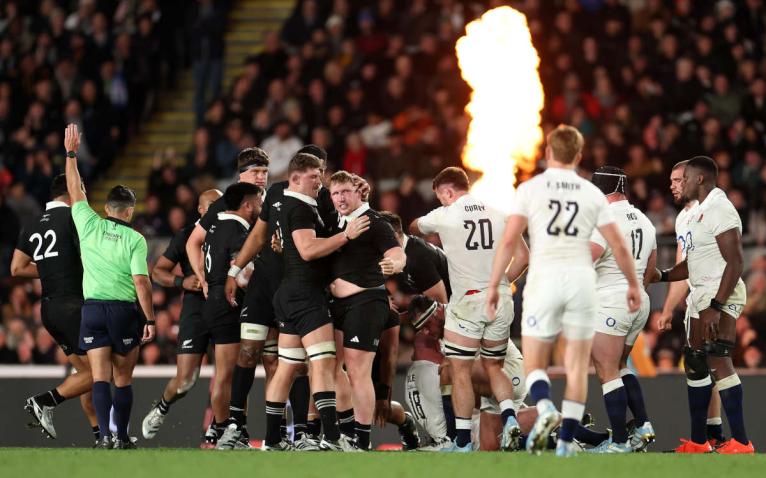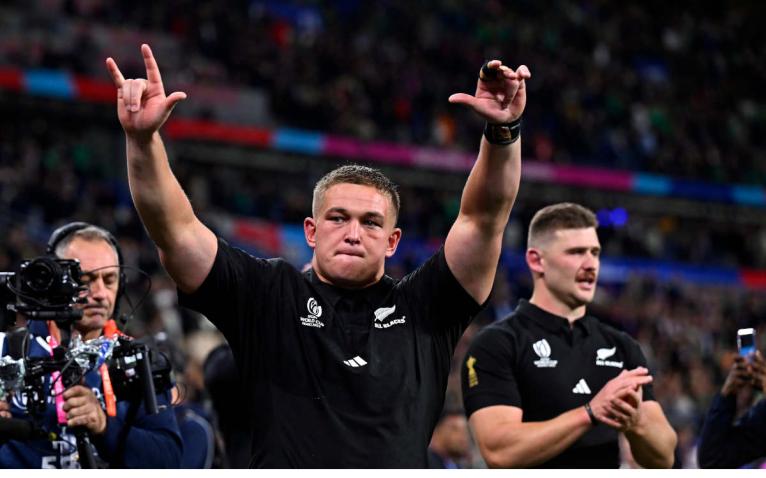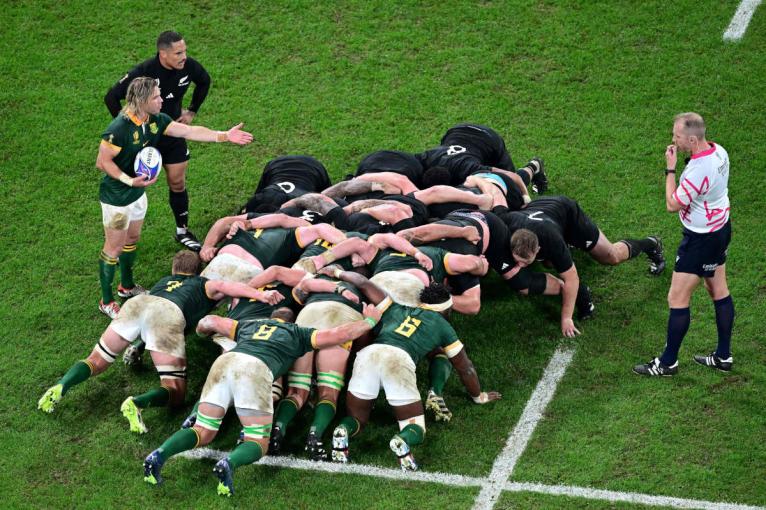Of all the decisions the All Blacks selectors had to make about who to keep and who to add to their Rugby Championship squad, the easiest would have been to rubber stamp the inclusion of all six props who featured against England and Fiji in July.
Easy, because in winning their first three tests of the year, the All Blacks confirmed they have a weaponised scrum and a cohort of props who may be the best the country has produced in the professional age.
As England discovered both in Dunedin and at Eden Park, the All Blacks have undeniable scrummaging power.
Had it not been for the All Blacks’ ability to win critical scrum penalties, they probably would have lost in Dunedin, and while England shored things up a little in Auckland a week later, they were still under intense pressure to win their own ball.
There was no doubt, across the two tests, the All Blacks had a dominant scrum, and its overall influence in helping them sneak two wins was significant.
A week later in San Diego, Fiji felt a similar set-piece wrath. The All Blacks destroyed Fiji in just about every scrum and were almost always operating under penalty advantage.

What made that scrum demonstration from the All Blacks yet more impressive, was the cast of personnel.
England faced the established propping duo of Ethan de Groot and Tyrel Lomax, with the veteran Ofa Tuungafasi and the emerging Fletcher Newell coming off the bench.
These four, by and large, have been the All Blacks preferred match day props since mid-2022.
But in San Diego, Tamaiti Williams started at loosehead and produced a display of raw power befitting his 140kg frame and later in the second half, Pasilio Tosi hauled all 145kg of himself off the bench to make an impressively destructive debut.
All of the props got their hands on the ball and showed they are dynamic ball carriers. Lomax and de Groot, in particular, have become huge contributors to the continuity game the All Blacks want to play.
There was, however, so much more to like about the way the All Blacks’ front-rowers played than just their scrummaging, however.
All of them got their hands on the ball and showed they are dynamic ball carriers. Lomax and de Groot, in particular, have become huge contributors to the continuity game the All Blacks want to play.
They are both comfortable with pass and catch, and they have the conditioning to keep getting off the ground to make tackles or be where they need to be to facilitate the attack.
They are impressively mobile – a skill that Tuungafasi and Fletcher are developing, too, with the latter rating as one of the most effective tacklers the All Blacks have.
As for Tosi and Williams, they may respectively be the heaviest and second heaviest props the All Blacks have ever capped, but their speed and agility ranks alongside some of the loose forwards.

Whatever else the All Blacks learned in their first three tests of the year, nothing will have pleased the coaching staff more than the discovery that they have six highly-mobile, all-court props who can handle themselves in the scrum and yet get around the field to contribute to the wider gameplan.
This combination of size, power, speed and agility is likely to prove transformational for the All Blacks throughout this year and indeed the rest of the World Cup cycle.
The All Blacks are trying to build a fluid, continuity game and two things are necessary for that to happen – a solid scrum that can provide a platform from which to launch effective strike moves and a pack loaded with ball carriers who can hurt opposition teams in the middle of the field.
They have two big ticks in both columns, plus an additional tick – which is the ability of the scrum to exert enough pressure to win penalties.
This ability to use the scrum to either win the chance to take three points, or kick deep to the corner, adds a whole new dimension to the All Blacks as it’s something they were not able to do last year.
The bit that seems too good to be true, is the respective ages of the group – Lomax has just turned 28, De Groot is barely 26, Newell is 24, Williams is 23, Tosi is 26 and Tuungafasi, who made his debut in 2016, is still just 32 and playing better than he ever has.
Not against the top sides at least and while dominating England doesn’t serve as definitive evidence the All Blacks can get the better of any set-piece, there’s growing confidence inside the camp that they are building the most destructive scrum in the world game.
And the bit that seems too good to be true, is the respective ages of the group – Lomax has just turned 28, De Groot is barely 26, Newell is 24, Williams is 23, Tosi is 26 and Tuungafasi, who made his debut in 2016, is still just 32 and playing better than he ever has.
The group is not only young, but relatively experienced, too, with de Groot, Lomax and Williams all playing in the World Cup final in 2023, Newell played in the quarter-final clash against Ireland and semifinal against Argentina while Tuungafasi has been to two World Cups and has 60-plus caps.
“They are all ball players, they are big men they have got good feet, and they can play short at the line you can see how mobile they are and they can scrum and that is one thing we are really excited about is the quality of the athletes that can scrum,” All Blacks head coach Scott Robertson says of the propping resource he has at his disposal.

“It is unique so and it gives them more chance to carry and use the ball a bit more and the same thing around the lineout, they are big, tall men so we can get some big lifts which is another strength of ours.”
Having this cohort of all-court props is the holy land the All Blacks felt they would never reach and the story of how they got here is fascinating.
When the All Blacks reached crisis point in August 2022, one of the major problems they couldn’t solve was their creaking scrum.
Strictly speaking that’s not true – the problem they had was that if they wanted to shore up their scrum, they needed to pick Nepo Laulala at tight-head, and while he was an outstanding scrummager, he offered next to nothing around the field.
And this was the nub of the problem – the All Blacks were producing props who could either scrum or get around the field.
None of them could offer both functions and it often meant that the cost of having a stable scrum was a lack of impact elsewhere.
To keep the scrum steady meant that the All Blacks were down on ball carriers; that their defensive line had 13 rather than 15 men in it, and that there was too much space around the fringes of the ruck because their scrummaging props were too slow to get to their feet and cover.
When Ireland came to New Zealand in 2022, and won the series 2-1 to make history, it illustrated perfectly the problem the All Blacks were facing.
It felt like a last desperate throw of the dice, as Lomax, who had won his first cap in 2018, spent most of Super Rugby in 2021 and 2022 looking like he was more interested in picking up yellow cards than he was setting scrums.
While all four Irish props in that series – Furlong, Healy, Andrew Porter and Finlay Bealham – played on their feet, carried hard, made tackles and rarely missed cleanouts, the All Blacks propping group of Laulala, Tuungafasi, Angus Ta’avao, Karl Tu’inukuafe and George Bower were split into two distinct groups: those who could scrummage but not contribute and those who could contribute but not scrummage.
It all started to change in South Africa two weeks later – but more by chance than by design.
When injury hit following the Irish series, Lomax was called in and ended up starting at Ellis Park.
This felt like the last desperate throw of the dice, as Lomax, who had won his first cap in 2018, spent most of Super Rugby in 2021 and 2022 looking like he was more interested in picking up yellow cards than he was setting scrums.

The potential everyone had talked about when he was poached from the Rebels back in 2017 felt misplaced.
But at Ellis Park, he not only scrummaged superbly, he got around the field, outplayed his South African counterparts and contributed majorly to the 35-23 victory.
He’s talked many times about that day and how he played with an attitude where he told himself that he should treat the game as a trial.
Even now, two years on, he said before the English clash at Eden Park, that remains his attitude. “I’ve definitely kept that same mentality. I still feel like I’ve got a chip on my shoulder from that year of I guess not making the All Blacks and wanting to still prove myself. You’re never guaranteed a spot in the All Blacks.”
The loose-head at Ellis Park happened to be De Groot, another to have missed out on selection for the Irish series only to earn a reprieve when Tu’inukuafe left for Montpellier.
Now they don’t have to choose between props who can scrum and props who can play and the superstars of this World Cup cycle are going to be de Groot, Lomax, Williams, Newell, Tuungafasi and Tosi.
He too proved that he had the scrummaging chops and all-round game the All Blacks weren’t getting from the props they originally picked and, amazingly, Newell was also called to South Africa midway through the tour, and he made his debut at Ellis Park.
In what was a crazy quirk of fate, three props not wanted at the start of 2022, used the bad luck of others to transform the pecking order and change the equation for the All Blacks.
Now they don’t have to choose between props who can scrum and props who can play and the superstars of this World Cup cycle are going to be de Groot, Lomax, Williams, Newell, Tuungafasi and Tosi.


Obviously this author is discussing the current team members, but he most certainly should have mentioned Numia. The lad can scrummage and is outstanding in the loose. Real shame he got the injury. And he's 25. Some say he's light but he is (officially) just 5kg less than Genge.
there was a noticeable dominance from the Blues forward pack throughout this years SRPacific competition and that was mainly due to Greg Feek....when he was with Jason Ryan they were both confident of their plan to match and counter the Bomb Squad in the RWC final and they held their own...and now Joe Schmidt has the scrum guru Mike Cron in his coaching staff...the team with forward pack dominance will have the advantage...Go the AB's..show it...own it..
Excellent stable of high quality props, will peak at RWC27. Need Darry and Holland to develop and soon, lock stocks and blindside barrels still look threadbare.
Surely Xavier Numia is next in line at loosehead behind Tu'ungafasi. He may be a little lighter than others, but it didn't stop him being one of the most effective and destructive scrummagers in SRP this year. He now has a complete game and would be a weapon off the bench in black.
Natural selection is random. Specifically, Jase Ryan's appointment in mid 2022 was the main difference in our vastly improved pack performance. Now, with Razor, a proper Head Coach, in charge, the world's once again our oyster over this next four-year cycle.
It is no secret how much lomax contributed to the hurricanes success this year. He was outstanding.
Size and mobility one thing, scrummaging ability another. Hopefully we can fast track these young guys to be top class scrumagers’s. We should be a lot clearer on this by the end of the year, if they get plenty of bench time. Hooker also going to be a strength with Aumoa, Samasoni and Bell all beasts in scrum and around the field. Need to fast track Taylor out of the team…33 years old and couldnt hit a barn door with his throwing when the pressures on
Have you watched a test match in 2023 or 2024?
The scrum at 2023 RWC with DeGroot & Lomax starting and Williams & Newell finishing was as good a scrum as any team in the world including the Springboks in the final.
The 2024 RWC has only unveiled that Tu’ungafasi has reached that very high level and Tosi shows promise but clearly not there yet.
NZ's scrum is already excellent. That should be clear already, but will be conformed against SA.
Excellent! Lomax in particular - what a transformation from being subbed before half-time when the Tah’s Angus Bell did him over in Super 2022, to his brilliant debut against the Boks! Bower has been floating around the ABs camp as cover, but wonder if Numia will be next cab off the rank at loose-head once he’s injury free? He’s probably the most dynamic carrier of any of them, and he was part of some dominant scrummaging with Aumua and Lomax/Tosi.
Hmm, Lomax didn't debut against the Boks in 2022. His first test was in 2018, against Japan.
Xavier Numia is too small for a test prop.
Great point about Numia, feel like he would've been in there this year had injury not done him over. Just need to get some of these boys playing for the mighty Chiefs!
We're in a great place moving forward and by the end of this cycle, I believe we'll be saying the same about our locking stocks with Lord, Holland and Darry coming of age.